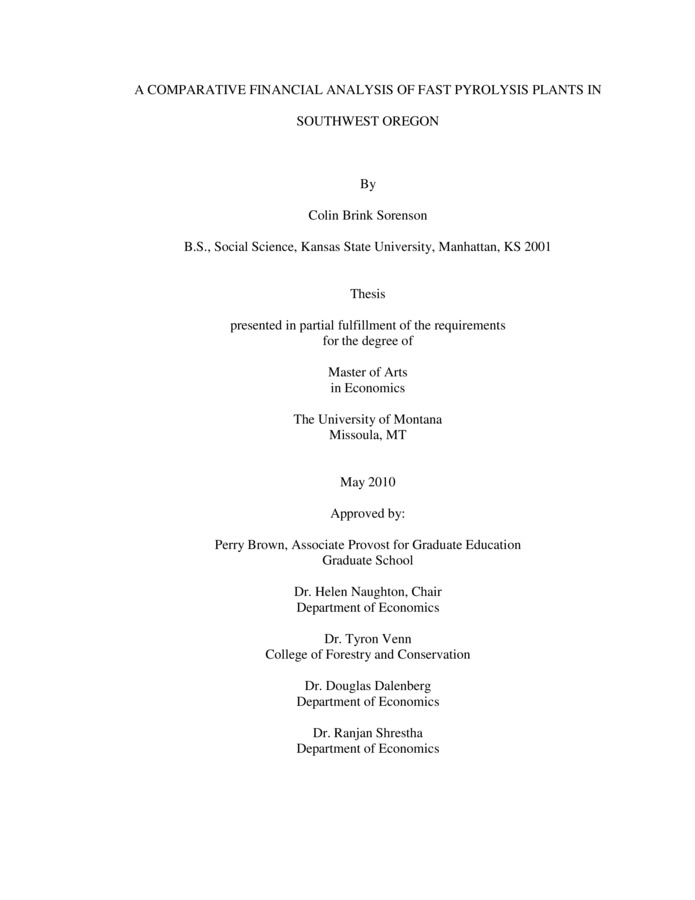PDF
A Comparative Financial Analysis of Fast Pyrolysis Plants in Southwest Oregon Item Info
- Title:
- A Comparative Financial Analysis of Fast Pyrolysis Plants in Southwest Oregon
- Creator:
- Sorenson, C.B.
- Date Created (ISO Standard):
- 2010-05-01
- Description:
- There are millions of acres of forestland in the Western United States that could benefitfrom fuel reduction treatments to improve forest health and reduce wildfire fuels. These treatments generate forest residues that are typically piled and burned. However, with increasing concerns about energy security, high oil prices, air quality from pile burning and climate change, there is great interest in examining ways to economically use these residues as a renewable energy source. Pyrolysis of forest biomass is one method that shows promise, though the financial feasibility of doing so has not been previously investigated. This study presents the expected financial performance of a mobile and a fixed pyrolysis plant in southwest Oregon, where stocks of forest biomass are high. The tradeoffs between using a smaller plant deployed in the forest and a larger centralized plant are then discussed. Pyrolysis of forest residues involves using advanced technology to thermally degrade biomass in the absence of oxygen to produce bio-oil, biochar and syngas. The syngas is used entirely to provide thermal process energy for the pyrolysis system. Bio-oil can substitute for #2 fuel oil in some applications or be upgraded to produce higher value products. Biochar can be used as a substitute for coal or a valuable soil amendment that can sequester carbon and improve desirable soil properties such as water and nutrient holding capacity. Information about costs, revenues and production rates for fast pyrolysis systems have been collected from existing pyrolysis firms and likely suppliers of goods and services to pyrolysis firms in Oregon. Financial performance is estimated using a discounted cash flow analysis to determine net present value (NPV) and internal rate of return (IRR) for each plant. Benefits of an in-woods mobile plant include shorter biomass haul distances that contribute to a lower raw material input cost of $20 per bone dry ton (BDT), as opposed to $45 per BDT for the larger fixed-site plant. The ability to operate separate from the electrical grid and re-locate multiple times per year gives flexibility to the mobile plant. Advantages of the fixed plant include cost savings from economies of scale and lower bio-oil delivery costs. The baseline financial performance assessments for both plants are encouraging, with positive NPV and estimates of 7% and 21% IRR for the mobile and fixed plants, respectively. Sensitivity analyses have revealed that financial performance is particularly dependent on initial capital costs, labor and feedstock costs, and projected bio-oil and bio-char prices.
- Subjects:
- research pyrolysis
- Source:
- Colin Sorenson, A Comparative Financial Analysis of Fast Pyrolysis Plants in Southwest Oregon, 2001
- Source Identifier:
- A_Comparative_Financial_Analysis_of_Fast_Pyrolysis_Plants_in_Southwest_Oregon_IFTNC_2010
- Type:
- Text
- Format:
- application/pdf
Source
- Preferred Citation:
- "A Comparative Financial Analysis of Fast Pyrolysis Plants in Southwest Oregon", Intermountain Forestry Cooperative, University of Idaho Library Digital Collections, https://www.lib.uidaho.edu/digital/iftnc/items/iftnc3759.html
Rights
- Rights:
- This document is provided by the University of Idaho Library for use by University of Idaho students, staff, and faculty. All rights to the document linked from this metadata belong to the author, rights holder, and/or provider. For more information contact The Intermountain Forestry Cooperative, https://www.uidaho.edu/cnr/ifc
- Standardized Rights:
- http://rightsstatements.org/vocab/InC-EDU/1.0/

